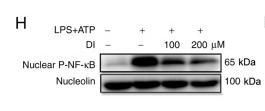NUCL Antibody - #DF12542
製品説明
*The optimal dilutions should be determined by the end user.
*Tips:
WB: For western blot detection of denatured protein samples. IHC: For immunohistochemical detection of paraffin sections (IHC-p) or frozen sections (IHC-f) of tissue samples. IF/ICC: For immunofluorescence detection of cell samples. ELISA(peptide): For ELISA detection of antigenic peptide.
引用形式: Affinity Biosciences Cat# DF12542, RRID:AB_2845504.
折りたたみ/展開
C23; FLJ45706; MS1116; NCL; Nucl; NUCL_HUMAN; Nucleolin; Protein C23;
免疫原
A synthesized peptide derived from human NUCL, corresponding to a region within the internal amino acids.
- P19338 NUCL_HUMAN:
- Protein BLAST With
- NCBI/
- ExPASy/
- Uniprot
MVKLAKAGKNQGDPKKMAPPPKEVEEDSEDEEMSEDEEDDSSGEEVVIPQKKGKKAAATSAKKVVVSPTKKVAVATPAKKAAVTPGKKAAATPAKKTVTPAKAVTTPGKKGATPGKALVATPGKKGAAIPAKGAKNGKNAKKEDSDEEEDDDSEEDEEDDEDEDEDEDEIEPAAMKAAAAAPASEDEDDEDDEDDEDDDDDEEDDSEEEAMETTPAKGKKAAKVVPVKAKNVAEDEDEEEDDEDEDDDDDEDDEDDDDEDDEEEEEEEEEEPVKEAPGKRKKEMAKQKAAPEAKKQKVEGTEPTTAFNLFVGNLNFNKSAPELKTGISDVFAKNDLAVVDVRIGMTRKFGYVDFESAEDLEKALELTGLKVFGNEIKLEKPKGKDSKKERDARTLLAKNLPYKVTQDELKEVFEDAAEIRLVSKDGKSKGIAYIEFKTEADAEKTFEEKQGTEIDGRSISLYYTGEKGQNQDYRGGKNSTWSGESKTLVLSNLSYSATEETLQEVFEKATFIKVPQNQNGKSKGYAFIEFASFEDAKEALNSCNKREIEGRAIRLELQGPRGSPNARSQPSKTLFVKGLSEDTTEETLKESFDGSVRARIVTDRETGSSKGFGFVDFNSEEDAKAAKEAMEDGEIDGNKVTLDWAKPKGEGGFGGRGGGRGGFGGRGGGRGGRGGFGGRGRGGFGGRGGFRGGRGGGGDHKPQGKKTKFE
種類予測
Score>80(red) has high confidence and is suggested to be used for WB detection. *The prediction model is mainly based on the alignment of immunogen sequences, the results are for reference only, not as the basis of quality assurance.
High(score>80) Medium(80>score>50) Low(score<50) No confidence
研究背景
Nucleolin is the major nucleolar protein of growing eukaryotic cells. It is found associated with intranucleolar chromatin and pre-ribosomal particles. It induces chromatin decondensation by binding to histone H1. It is thought to play a role in pre-rRNA transcription and ribosome assembly. May play a role in the process of transcriptional elongation. Binds RNA oligonucleotides with 5'-UUAGGG-3' repeats more tightly than the telomeric single-stranded DNA 5'-TTAGGG-3' repeats.
Some glutamate residues are glycylated by TTLL8. This modification occurs exclusively on glutamate residues and results in a glycine chain on the gamma-carboxyl group (By similarity).
Symmetrically methylated by PRMT5.
Nucleus>Nucleolus. Cytoplasm.
Note: Localized in cytoplasmic mRNP granules containing untranslated mRNAs.
研究領域
· Human Diseases > Infectious diseases: Bacterial > Pathogenic Escherichia coli infection.
参考文献
Application: WB Species: Mice Sample: microglial cells
Restrictive clause
Affinity Biosciences tests all products strictly. Citations are provided as a resource for additional applications that have not been validated by Affinity Biosciences. Please choose the appropriate format for each application and consult Materials and Methods sections for additional details about the use of any product in these publications.
For Research Use Only.
Not for use in diagnostic or therapeutic procedures. Not for resale. Not for distribution without written consent. Affinity Biosciences will not be held responsible for patent infringement or other violations that may occur with the use of our products. Affinity Biosciences, Affinity Biosciences Logo and all other trademarks are the property of Affinity Biosciences LTD.





